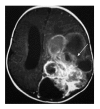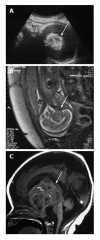Fetal brain tumors: Prenatal diagnosis by ultrasound and magnetic resonance imaging
- PMID: 25628801
- PMCID: PMC4295174
- DOI: 10.4329/wjr.v7.i1.17
Fetal brain tumors: Prenatal diagnosis by ultrasound and magnetic resonance imaging
Abstract
Congenital central nervous system tumors diagnosed during pregnancy are rare, and often have a poor prognosis. The most frequent type is the teratoma. Use of ultrasound and magnetic resonance image allows the suspicion of brain tumors during pregnancy. However, the definitive diagnosis is only confirmed after birth by histology. The purpose of this mini-review article is to describe the general clinical aspects of intracranial tumors and describe the main fetal brain tumors.
Keywords: Brain tumors; Fetus; Magnetic resonance imaging; Teratoma; Ultrasound.
Figures




References
-
- Cavalheiro S, Moron AF, Hisaba W, Dastoli P, Silva NS. Fetal brain tumors. Childs Nerv Syst. 2003;19:529–536. - PubMed
-
- Meizner I. Tumors of the Brain. In: Ultrasonography of the prenatal brain., editor. 3rd ed. McGrawHill: New York; 2012. pp. 393–406.
-
- Cassart M, Bosson N, Garel C, Eurin D, Avni F. Fetal intracranial tumors: a review of 27 cases. Eur Radiol. 2008;18:2060–2066. - PubMed
-
- Hoff NR, Mackay IM. Prenatal ultrasound diagnosis of intracranial teratoma. J Clin Ultrasound. 1980;8:247–249. - PubMed
Publication types
LinkOut - more resources
Full Text Sources
Other Literature Sources

